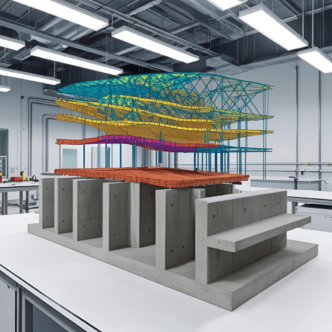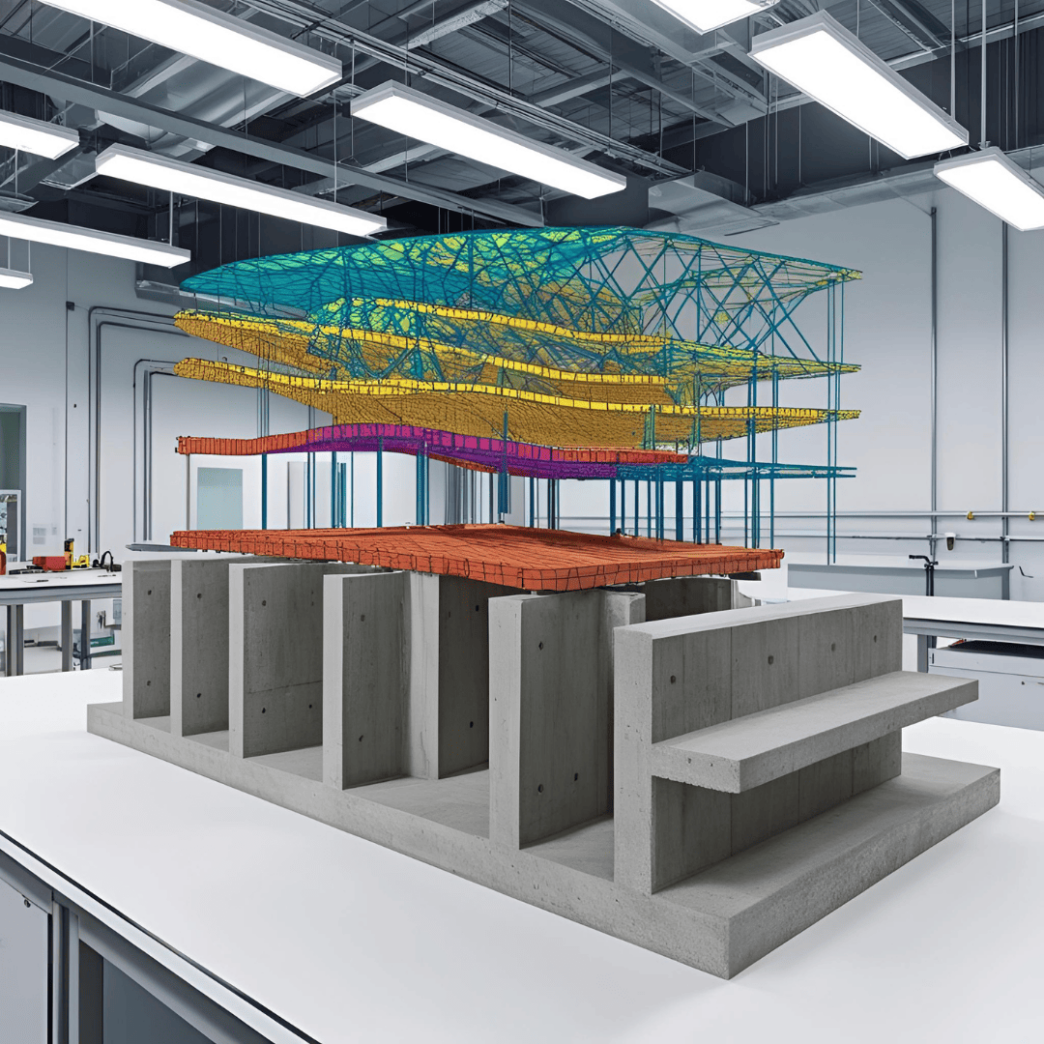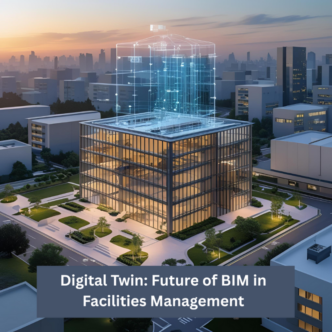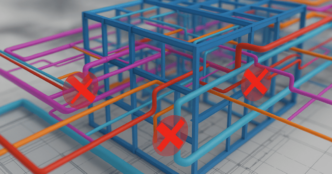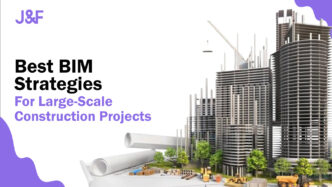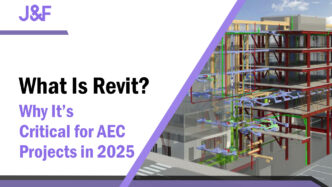Reinforced concretes (RCs) are widely used within the construction landscape for their sheer compression and tensile strength. However, they aren’t failure-proof. Poor design, improper testing, and substandard materials can jeopardize their quality. Therefore, testing them thoroughly against varied loads and environmental conditions is paramount. Speaking of testing, Nonlinear Finite Element Analysis (NLFEA) has emerged as a gold standard for testing RCs. Structural engineers and design experts increasingly use NLFEA to verify RCs for load-bearing capacity, compression strength, and tensile strength. Let’s see how nonlinear finite element analysis has transformed the AEC industry, especially when it comes to constructing reinforced concrete buildings.
Understanding Nonlinear Finite Element Analysis
Nonlinear Finite Element Analysis is an advanced simulation technique emphasizing true stress-strain relationships. Unlike linear analysis, NLFEA tests structures under various loads by leveraging:
- Contact effects
- Geometric nonlinearity
- Material nonlinearity
Unlike linear analysis, NLFEA can seamlessly capture the true stress-strain relationships, unveiling cracking, yielding, and failure of materials. In the case of RCS, NLFEA can shed light on the complex interaction between steel bars and concrete, showcasing how both react under various loads.
Explore our expertise in BIM Services and how simulation fits into smarter designs.
Why Nonlinear Analysis is Crucial for RC Structures
Concrete works great when it comes to compression, but the same is not true when it comes to tension. That is where steel reinforcement comes into play. Embedded in strategic locations, steel reinforcement can significantly elevate the concrete’s tensile strength. On top of that, RC structures become highly nonlinear, especially when they are subject to seismic loads, extreme weather, or long-term deterioration.
Traditional linear models fall short in predicting:
- Crack propagation
- Plastic hinge formation
- Bond-slip effects
- Progressive collapse
- Post-yield behaviour of steel
On the other hand, advanced finite element methods, specifically nonlinear ones, enable engineers to simulate and visualize every stage of structural response.
Looking for advanced analytical support? Check our BIM Consulting Services.
Key Components of Nonlinear Finite Element Modeling
At J&F, our experts extensively rely on advanced finite element methods to create precision-driven models of RC structures. Here’s how this method works.
1. Material Modeling
Accurate material definitions are critical:
Concrete: Modeled with damage plasticity, smeared crack, or plasticity-based models to simulate cracking, crushing, and stiffness degradation.
Steel Reinforcement: Simulated with bilinear or multi-linear stress-strain curves, capturing yielding and strain hardening.
Bond Behavior: Interface elements or embedded models simulate the interaction between steel and concrete, including slippage.
Need to model a complex RC structure? Talk to our specialists.
2. Geometric Nonlinearity
For structures undergoing large displacements, geometric effects become significant. Nonlinear finite element analysis captures:
- P-Delta effects
- Buckling
- Lateral torsional deformations
3. Element Types
- Solid elements for concrete
- Truss or beam elements for rebar
- Interface elements for bond-slip or contact
4. Loading and Boundary Conditions
NLFEA can model:
- Static and dynamic loads
- Earthquake simulations
- Time-dependent effects like creep and shrinkage
Benefits of Nonlinear Finite Element Analysis in Construction
At J&F, we strive to integrate nonlinear finite element analysis into the design and testing phase. Doing so helps us experience the following benefits:
1. Accurate Performance Prediction
NLFEA is far away from assumptions and centers around accuracy based on real scenarios, giving a clear picture of how structures will behave under varied conditions.
2. Failure Mode Identification
Identify structural pain points, no matter the severity level or impact. It can help engineers overcome imminent threats that could become reality.
3. Optimised Structural Design
By pinpointing the exact strength of the structure, we can optimize where to place reinforcement components for improved structural performance. This can dramatically improve material efficacy and cost savings.
4. Improved Safety and Code Compliance
The nonlinear models can help engineers to zero in on safety codes, especially when catering to seismic regions. It can help strike the right balance between structural performance and code compliance.
Learn how our MEP BIM Services and structural simulations work together for holistic project safety.
5. Rehabilitation and Retrofit Planning
NLFEA can effortlessly pinpoint pain points within structures regardless of their age, size, or design. It can prove to be handy in guiding effective retrofitting strategies.
Top Software For Nonlinear Finite Element Analysis
To maintain precision and efficiency, engineers worldwide focus on the best tools, including:
- ABAQUS
- ANSYS
- DIANA FEA
- OpenSees
- ATENA
These tools support nonlinear finite element modeling, offering.
- High degrees of customisation,
- Multi-physics capabilities
- Visualization tools for better decision-making.
Challenges With Advanced Finite Element Methods
Despite being impactful and advanced, Nonlinear Finite Element Analysis is not without challenges. These include:
Computational intensity: Leveraging NLFEA at scale can be a concern for cost-conscious projects because it requires significant processing power to make models work.
Convergence issues: Zeroing in on parameters is the key to accurate modeling. Any error can cause the model to render an inaccurate result, leading to compromised construction.
Calibration complexity: Keeping the material models and experimental or field data on the same page can be a daunting challenge.
At J&F, our team mitigates these issues by:
- Capitalising on cloud-based solvers and high-performance computing (HPC)
- Performing model validation within the purview of laboratory or in situ results
- Making use of incremental loading and stabilisation strategies to ensure convergence
Also read: Why Hiring a BIM Consultant is Crucial for Successful Project Execution
The Future of Structural Engineering with NLFEA
The world of construction is evolving, and so are the demands for durable and long-lasting projects. On top of that, the ever-changing design landscape is presenting engineers with challenges to elevate structural performance while staying aligned with building codes. With Nonlinear Finite Element Analysis, the construction industry will undergo a dramatic transformation that will redefine the structural testing and RC deployments.
Why Choose J&F for Advanced Finite Element Solutions
J&F is committed to redefining construction endeavors by adhering to modern technologies and closely monitoring trends. When it comes to Nonlinear Finite Element Analysis, we strive to elevate structural performance and quality by focusing on:
- Cutting-edge tools and techniques
- Custom solutions tailored to your structural challenges
- Collaborative approach with architects, consultants, and developers
Looking to strengthen your next project? Let’s collaborate. Whether you’re kickstarting a project with complex architectural needs or planning retrofits, J&F’s advanced finite element analysis services will take you to the next level.
Conclusion
In today’s construction landscape, balancing construction quality with cost can be taxing. With Nonlinear Finite Element Analysis (NLFEA), engineers can go an extra mile when it comes to taking a granular look at structural elements and their quality. This method can be a game-changer in uncovering hidden vulnerabilities and ensuring safer and more sustainable designs.
